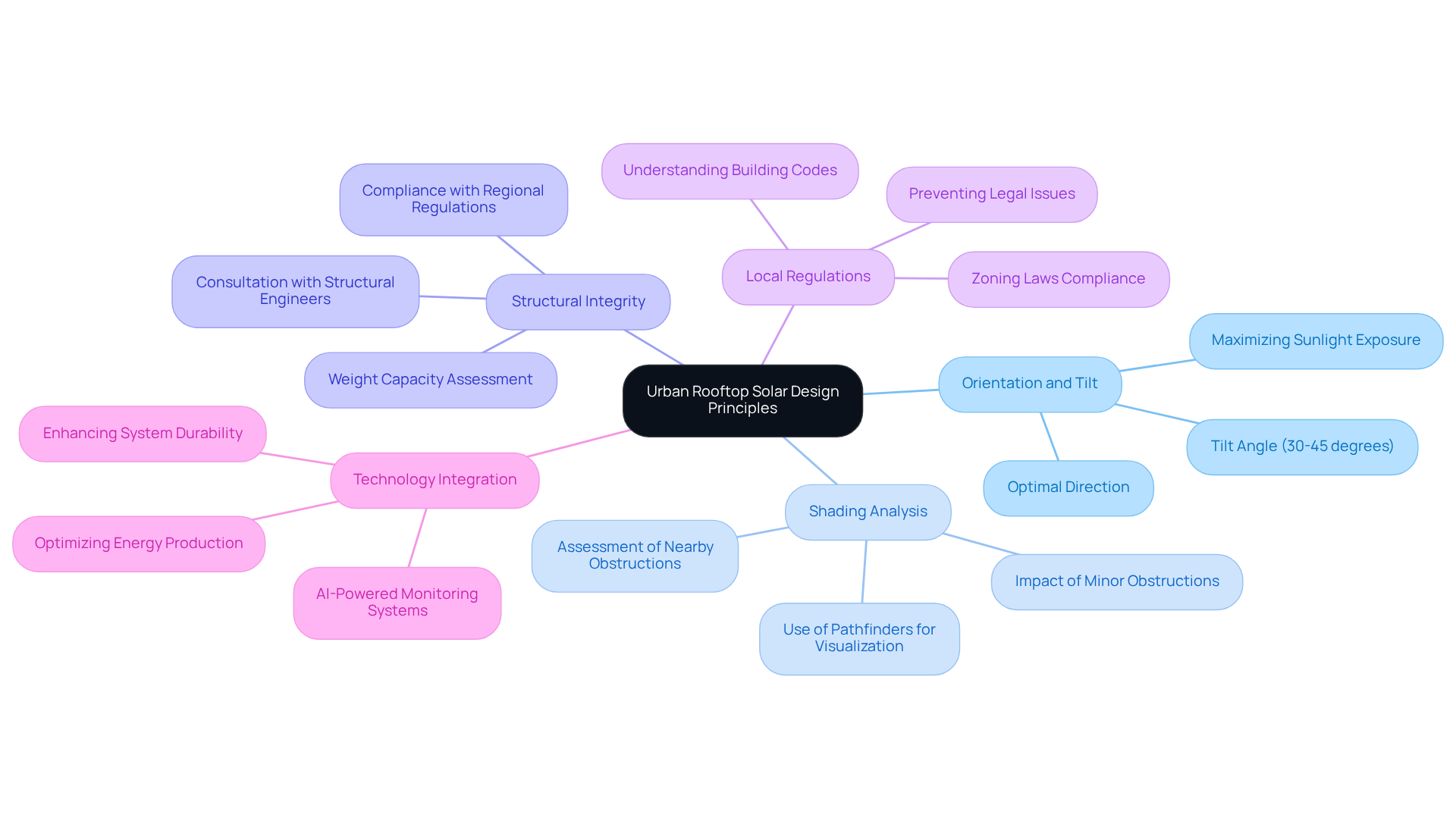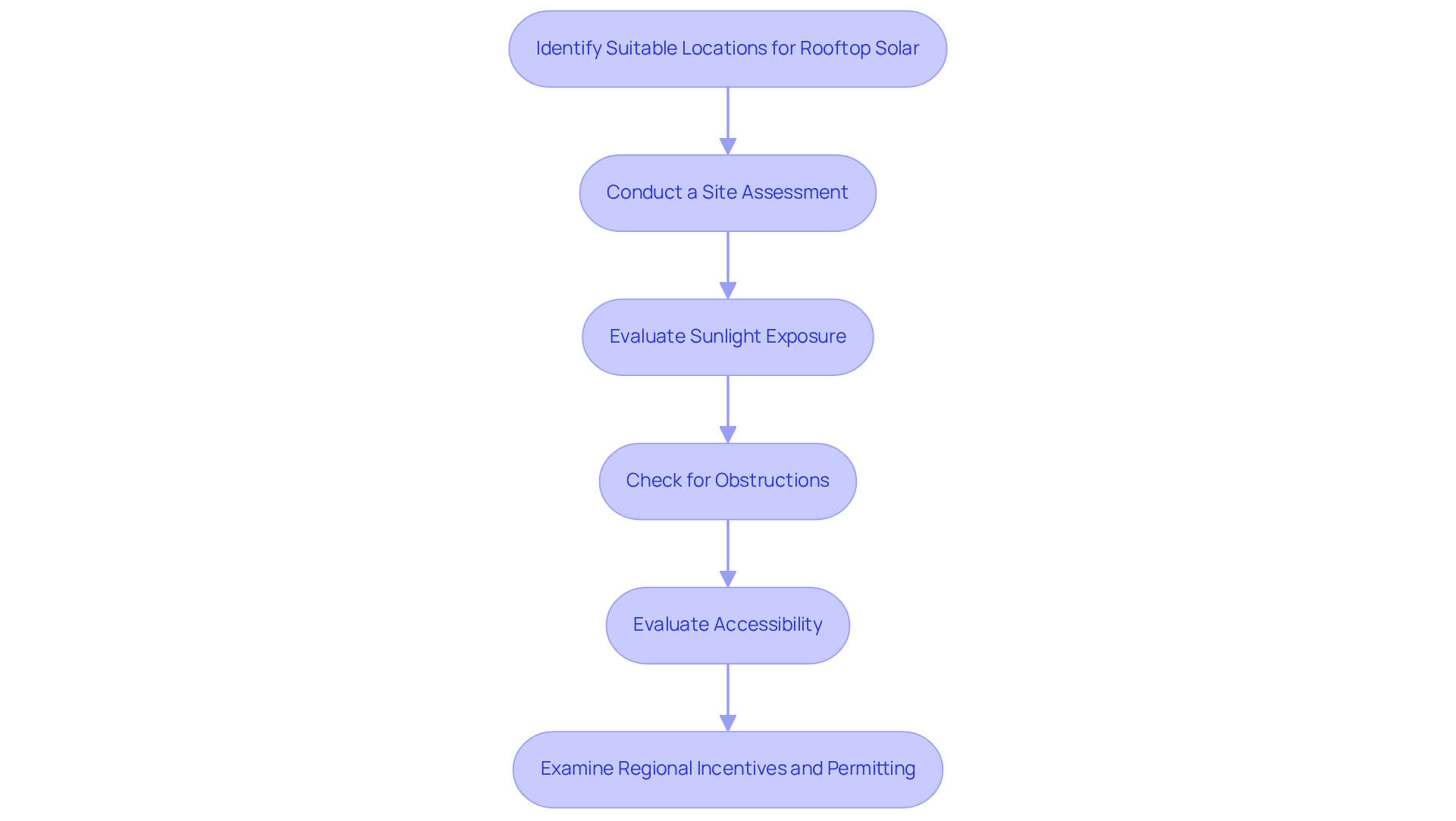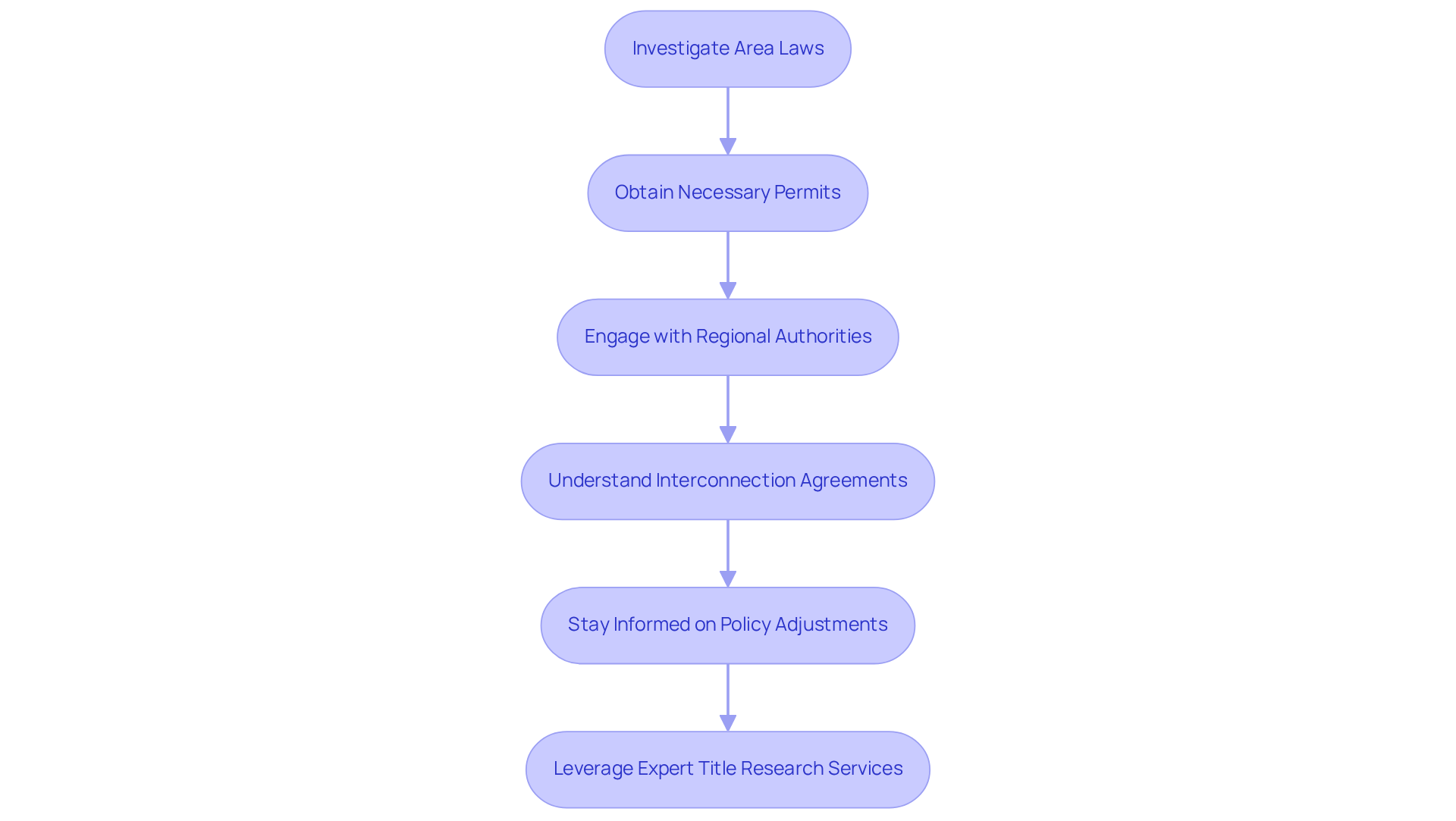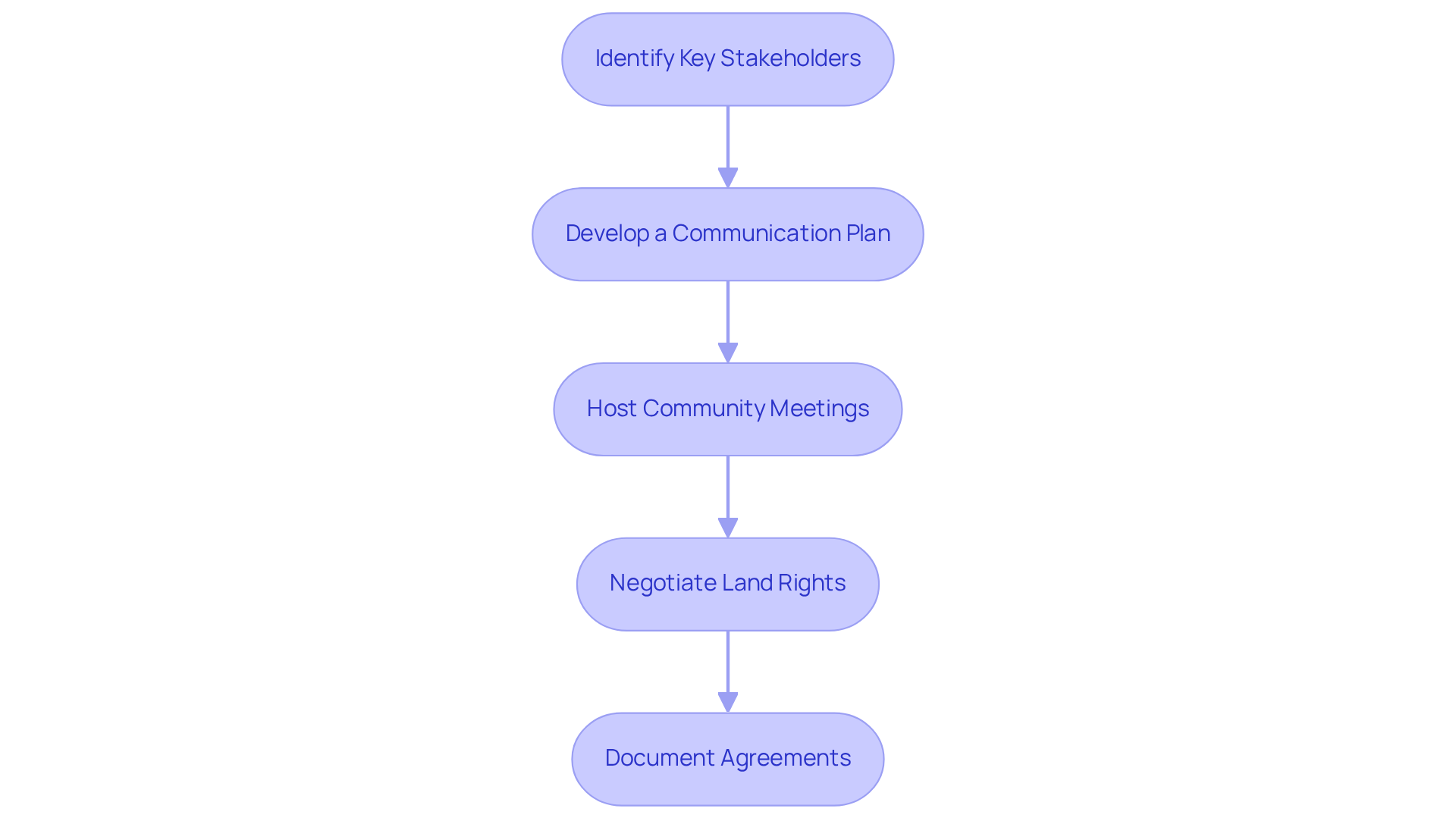Overview
The article addresses the pressing challenges of mastering urban rooftop solar designs, particularly concerning land acquisition. It highlights the critical need for a deep understanding of solar design principles, thorough site assessments, and the navigation of complex legal requirements. Engaging stakeholders is essential for ensuring successful and compliant solar installations in urban environments. By recognizing these complexities, readers can appreciate the value of strategic planning and informed decision-making in this evolving field.
Introduction
Mastering urban rooftop solar designs extends beyond merely harnessing sunlight; it involves navigating a complex landscape of regulations, stakeholder interests, and optimal site selection. As cities increasingly embrace renewable energy solutions, grasping the principles and strategies behind effective land acquisition is essential for successful implementation. However, various challenges, such as legal compliance and community engagement, raise a critical question: how can one ensure that their rooftop solar project not only meets energy needs but also aligns with urban development goals?
Understand Urban Rooftop Solar Design Principles
To master urban rooftop solar designs, it is essential to understand key principles that can significantly enhance your energy production and ensure compliance with regulations.
-
Orientation and Tilt: Solar panels should ideally face south (or north in the Southern Hemisphere) and be tilted at an angle between 30 to 45 degrees to maximize sunlight exposure throughout the day. Recent advancements suggest that optimizing these angles can significantly boost energy production, aligning with the trend of improving efficiency in renewable energy.
-
Shading Analysis: Assess potential shading from nearby buildings or trees. Devices such as pathfinders can assist in visualizing shading patterns. A thorough shading analysis is crucial, as even minor obstructions can reduce energy output.
-
Structural Integrity: Ensure that the rooftop can support the weight of solar panels and associated equipment. Consulting with structural engineers is advisable to confirm the roof's capacity and safety, ensuring adherence to regional regulations.
-
Local Regulations: Understanding local building codes and zoning laws that may influence setup is paramount. Adherence is crucial to prevent legal problems and guarantee a seamless setup process. Familiarity with these regulations can prevent costly delays.
-
Technology Integration: Consider incorporating advanced technologies such as AI-powered monitoring systems to optimize energy production and maintenance. These innovations can significantly improve the efficiency and durability of renewable energy systems. As noted by experts, the integration of AI can streamline operations and enhance overall performance.
By grasping these principles, you can effectively prepare for successful urban rooftop solar designs, ensuring they are both efficient and compliant with local regulations. The increasing trend of renewable energy adoption, exemplified by California obtaining nearly 40% of its electricity from this energy source, underscores the importance of these principles in urban environments.

Identify Suitable Locations for Rooftop Solar
Identifying suitable locations for urban rooftop solar designs requires a systematic approach that considers several critical factors.
-
Conduct a Site Assessment: Start by evaluating the physical characteristics of potential surfaces, focusing on size, shape, and orientation. In urban rooftop solar designs, flat or slightly sloped roofs are generally preferred, as they facilitate optimal panel placement. Utilizing advanced tools such as satellite imagery and 3D modeling can provide accurate evaluations of surface suitability.
-
Evaluate Sunlight Exposure: Employ sunlight calculators and advanced tools to measure the light each location receives throughout the year. Ideal rooftops should receive a minimum of 5-6 hours of direct sunlight daily to maximize energy production. On average, photovoltaic panels generate approximately 1.5 kWh of energy, making sunlight exposure a crucial factor in energy production.
-
Check for Obstructions: Identify any potential barriers that could cast shadows on the photovoltaic panels, including nearby buildings or trees. This step is essential, as even minor shading can significantly reduce solar efficiency.
-
Evaluate Accessibility: Ensure that the rooftop is easily reachable for both setup and ongoing maintenance. Consider safety measures for workers during the installation process to prevent accidents and ensure adherence to regional regulations.
-
Examine Regional Incentives and Permitting: Investigate municipal government incentives or programs that promote renewable energy implementation. These incentives can greatly influence the financial feasibility of photovoltaic projects and should be factored into site selection decisions. Additionally, acquiring necessary permits and ensuring compliance with local regulations is vital for the successful implementation of elevated energy systems.
By meticulously evaluating these elements, you can accurately identify the most suitable surfaces for urban rooftop solar designs, ensuring a successful and efficient implementation of renewable solutions.

Navigate Legal and Regulatory Requirements
Navigating the legal and regulatory requirements for urban rooftop solar designs is critical for success. To effectively address these challenges, follow these steps:
- Investigate Area Laws: Familiarize yourself with regional zoning laws, building codes, and specific regulations related to urban rooftop solar designs, including height restrictions and aesthetic guidelines.
- Obtain Necessary Permits: Identify and apply for all required permits, such as building and electrical permits. Ensure your application includes detailed plans and specifications to avoid delays.
- Engage with Regional Authorities: Establish communication with regional planning and zoning boards to clarify any questions regarding regulations. This proactive approach will facilitate the permitting process.
- Understand Interconnection Agreements: If connecting to the grid, thoroughly review the interconnection requirements set by nearby utilities. Be prepared for additional permits and inspections that may be necessary.
- Stay informed on policy adjustments affecting urban rooftop solar designs: Keep abreast of any changes in regional, state, or federal regulations that could impact renewable energy initiatives. Given the rapid evolution of rules, staying informed is essential.
- Leverage Expert Title Research Services: Utilize Harbinger Land's advanced title research solutions to ensure that all land rights are thoroughly vetted. This expertise provides the confidence needed to navigate the complexities of land acquisition.
By proactively addressing these legal and regulatory aspects and leveraging expert title research, you can mitigate risks and ensure a smoother acquisition process.

Engage Stakeholders and Negotiate Land Rights
To successfully engage stakeholders and negotiate land rights for rooftop solar installations, it is essential to follow a strategic approach:
- Identify Key Stakeholders: Recognize essential stakeholders, including property owners, local government officials, community members, and utility companies. Their involvement is crucial for project success.
- Develop a Communication Plan: Establish a comprehensive communication strategy that includes regular updates and opportunities for stakeholder feedback. This approach not only informs but also builds trust, which is vital for project acceptance.
- Host Community Meetings: Organize community meetings to present the project, address concerns, and gather input. Engaging the community fosters transparency and can significantly enhance support for the project. Studies indicate that projects with active stakeholder engagement are up to 70% more likely to meet their original goals.
- Negotiate Land Rights: Approach landowners with well-prepared proposals that clearly outline the advantages of photovoltaic installations. Be ready to discuss compensation, lease terms, and any potential impacts on their property, ensuring that their concerns are addressed. Utilizing Harbinger Land's efficient document imaging solutions can streamline the process of obtaining and managing necessary documentation, making negotiations smoother and more effective. Access to digitized property data can help quickly resolve disputes over land boundaries or usage rights, facilitating a more efficient negotiation process.
- Document Agreements: Ensure that all agreements are thoroughly documented and legally binding. This includes leases, easements, and any other relevant contracts, which are essential for protecting both parties' interests. Harbinger Land's capabilities in digitizing property data can facilitate this process, ensuring that title research and leasing are conducted efficiently and cost-effectively. By having all documents readily accessible and organized, the risk of miscommunication or oversight is significantly reduced.
By implementing these strategies, you can cultivate strong relationships with stakeholders and secure the necessary land rights for your solar project, particularly focusing on urban rooftop solar designs, ultimately contributing to its success and sustainability.

Conclusion
Mastering urban rooftop solar designs is not merely a technical challenge; it is a multifaceted endeavor that demands a comprehensive understanding of various principles, effective site selection, and the navigation of intricate legal complexities. By integrating these elements, individuals and organizations can significantly enhance energy efficiency while contributing to a more sustainable urban environment.
Key insights from the article underscore the critical importance of the orientation and tilt of solar panels, conducting thorough site assessments, and engaging with stakeholders throughout the entire process. Furthermore, grasping local regulations and securing land rights are essential steps that must not be overlooked. Each of these components plays a pivotal role in ensuring the success of rooftop solar installations, ultimately leading to increased energy production and compliance with legal requirements.
As urban areas increasingly embrace renewable energy solutions, the significance of effective rooftop solar designs becomes ever more apparent. Stakeholders are urged to take proactive steps in site evaluation and community engagement, ensuring that projects align with both environmental objectives and local interests. By fostering collaboration and adhering to best practices, urban rooftop solar installations can flourish, paving the way for a cleaner, more sustainable future.
Frequently Asked Questions
What are the key principles for urban rooftop solar design?
The key principles include orientation and tilt of solar panels, shading analysis, structural integrity, understanding local regulations, and technology integration.
What is the ideal orientation and tilt for solar panels?
Solar panels should ideally face south (or north in the Southern Hemisphere) and be tilted at an angle between 30 to 45 degrees to maximize sunlight exposure.
Why is shading analysis important in solar design?
Shading analysis is crucial because even minor obstructions from nearby buildings or trees can significantly reduce energy output. Devices like pathfinders can help visualize shading patterns.
How can I ensure the structural integrity of my rooftop for solar panel installation?
It is advisable to consult with structural engineers to confirm that the rooftop can support the weight of solar panels and associated equipment, ensuring compliance with regional regulations.
What local regulations should I be aware of when installing rooftop solar?
Familiarity with local building codes and zoning laws is essential, as these regulations can influence the setup process and help prevent legal issues and costly delays.
How can technology integration improve urban rooftop solar systems?
Incorporating advanced technologies, such as AI-powered monitoring systems, can optimize energy production and maintenance, enhancing the efficiency and durability of renewable energy systems.
Why is understanding these principles important in the context of renewable energy?
Understanding these principles is vital as they ensure that urban rooftop solar designs are efficient and compliant with local regulations, contributing to the increasing trend of renewable energy adoption.
List of Sources
- Understand Urban Rooftop Solar Design Principles
- Quotes About Solar Power: 50 Picks to Light Up Your Life - Lumify Energy (https://lumifyenergy.com/blog/quotes-about-solar-power)
- ‘We want it to feel like magic’: Sunnova on saving time with AI rooftop solar designs (https://pv-tech.org/we-want-it-to-feel-like-magic-sunnova-saving-time-ai-rooftop-solar-designs)
- Top 10 Inspiring Quotes About Solar Energy - Solar academy (https://solar-academy.com/top-10-inspiring-quotes-about-solar-energy)
- Top Ten Quotes about Solar Power (https://harnessoursun.com/top-ten-quotes-about-solar-power)
- Identify Suitable Locations for Rooftop Solar
- Solar Site Assessment: Is My House Suitable for Solar Panels? (https://skylinesolar.com.au/solar-site-assessment)
- Important points to remember for roof solar installation (https://navitassolar.in/key-points-for-roof-solar-installation)
- Deep learning-based framework for city-scale rooftop solar potential estimation by considering roof superstructures (https://sciencedirect.com/science/article/pii/S0306261924012224)
- Engage Stakeholders and Negotiate Land Rights
- 20 Quotes To Get You Inspired For a Renewable Future - Solstice (https://solstice.us/solstice-blog/20-quotes-for-a-renewable-future)
- What Statistics Indicate The Impact of Stakeholder Engagement? → Question (https://sustainability-directory.com/question/what-statistics-indicate-the-impact-of-stakeholder-engagement)
- (PDF) Stakeholder engagement and influence: Strategies for successful energy projects (https://researchgate.net/publication/382514218_Stakeholder_engagement_and_influence_Strategies_for_successful_energy_projects)




